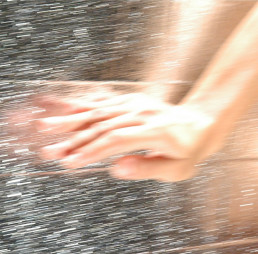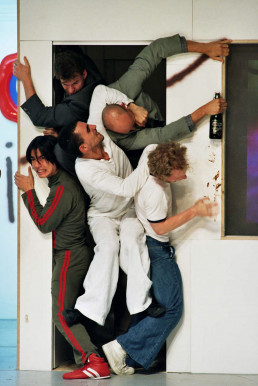“JOURNEY TO THE MOON, 7 FRAGMENTS FOR GEORGES MÉLIÈS, DAY FOR NIGHT”
William Kentridge
A obra de William Kentridge, uma das mais significativas da atualidade, oferece uma visão distintiva da história complexa da África do Sul e do legado do apartheid e é considerada, mais amplamente, uma viagem sobre a natureza das emoções humanas e da memória.
São apresentados no Museu do Chiado – MNAC as instalações Journey to the Moon, 7 Fragments for Georges Méliès e Day for Night, todas de 2003.
Em 7 Fragments for Georges Méliès a fonte de inspiração de Kentridge foi o trabalho de Méliès, parisiense nascido em 1861 e filho de um rico industrial do calçado. Depois de realizar estudos artísticos, Georges Méliès comprou o teatro de Robert Houdin usando-o para exibir filmes, antes de começar, ele próprio, a produzir e realizar obras da sua autoria.
Quanto a Journey to the Moon diz William Kentridge: “Um foguetão em forma de bala despenha-se na superfície de lua, um charuto espetado numa cara redonda. Quando vi o filme de Méliès pela primeira vez no início deste projeto, percebi que conhecia esta imagem muito antes de ter ouvido falar em Georges Méliès, o projeto 7 Fragments ia já bastante adiantado. Até então tinha resistido a pressões narrativas, interrogando-me sobre as premissas desta série de trabalhos, o que normalmente acontece quando o artista começa às voltas no estúdio. A conclusão foi a necessidade de fazer pelo menos um filme que se rendesse a um empurrão narrativo.”
Day for Night tem origem no exercício feito pelo artista de filmar formigas no estúdio enquanto se dedicava a Méliès: “Estava a trabalhar em Journey to the Moon, a penúltima e a mais complicada das peças de Méliès, quando fui abalroado pela ideia de inverter o filme usando as formigas para algumas sequências noturnas de Journey”.
William Kentridge tornou-se famoso no mundo inteiro através de curta-metragens de animação realizadas a partir de desenhos a carvão. No entanto, o seu envolvimento com o mundo das artes começou pelo teatro, primeiro como designer e ator, mais recentemente como realizador. Kentridge tem trabalhado, desde 1992, com a Handspring Puppet Company, numa série de espetáculos multimédia envolvendo atores, marionetas, projeções de vídeo, animação, palavras e música. Muito embora, ao longo da sua carreira, Kentridge tenha tocado as áreas do cinema e do teatro, a pintura continua a ser a força motriz da sua arte. Aliás, o artista considera que os seus trabalhos, sejam de animação, sejam de teatro, são apenas extensões da sua pintura.
Nascido em Joanesburgo em 1955, vive e trabalha na África do Sul.
Journey to the Moon (Viagem à Lua) (2003)
Filme 16 mm, filme 35 mm e mini-DV transferidos para DVD, som, 7’10”
Música: Philip Miller
Montagem: Catherine Meyburg
Cortesia Marian Goodman Gallery, Nova Iorque/Paris
7 Fragments for Georges Méliès (7 Fragmentos para Georges Méliès) (2003)
Filme 16 mm, filme 35 mm e mini-DV transferidos para DVD, som, 16’10”
Montagem: Catherine Meyburg
Cortesia Marian Goodman Gallery, Nova Iorque/Paris
Day for Night (O Dia pela Noite) (2003)
Filme 16 mm e mini-DV transferidos para DVD, som, 7′
Montagem: Catherine Meyburg
Cortesia Marian Goodman Gallery, Nova Iorque/Paris
“JOURNEY TO THE MOON, 7 FRAGMENTS FOR GEORGES MÉLIÈS, DAY FOR NIGHT”
William Kentridge
This first exhibition of William Kentridge in Portugal included the installations Journey to the Moon, 2003, and 7 Fragments for Georges Méliès including Day for Night, 2003, originally produced for (and first shown) at BAC-Baltic Art Center Visby, Sweden, and also the animated films Felix in Exile (1994) and History of the Main Complaint (1996), presented in documenta X, in 1997.
In 7 Fragments for Georges Méliès, William Kentridge’s source of inspiration is the work of Georges Méliès, a son of a rich shoemaker, born in Paris in 1861. After finishing his fine art studies, Georges Méliès bought the Theatre of Robert Houdin and started showing movies, before making and producing films himself.
About Journey to the Moon, William Kentridge writes: “A bullet-shaped rocket crashes into the surface of the moon, a fat cigar plunged into a round face. When I first saw the film of Méliès at the beginning of this project, I realized that I knew this image long before I heard of Georges Méliès, I was already far advanced in the making of the fragments for Méliès. Until then I had resisted the narrative pressures, wondering about the premises of this series of works, which usually happens when the artist begins to walk around in the studio. The conclusion was the need to make at least one film that surrendered to a narrative thrust.”
Day for Night has its origin from an exercise of filming ants in the artist’s studio, while working on the films of Méliès: “At this stage I was working on Journey to the Moon, the penultimate and most complicated of the Méliès pieces, when I was rammed by the idea of reversing the film and use the ants for some of the night sequences in the journey.”
William Kentridge became famous throughout the world by his animated short films made from charcoal drawings. However, his involvement with the world of the arts began with theater, first as a designer and actor, most recently as a director. Kentridge has been working with the Handspring Puppet Company since 1992 in a series of multimedia shows involving actors, puppets, video projections, animation, words and music. Although, throughout his career, Kentridge has touched the areas of film and theater, painting continues to be the driving force of his art. In fact, the artist considers that his works, whether of animation or theater, are only extensions of his painting.
Born in Johannesburg in 1955, he lives and works in South Africa.
Journey to the Moon (2003)
16mm film, 35mm film and mini-DV transferred to DVD, sound, 7’10”
Soundtrack: Philip Miller
Editor: Catherine Meyburg
Courtesy Marian Goodman Gallery, New York/Paris
7 Fragments for Georges Méliès (2003)
16mm film, 35mm film and mini-DV transferred to DVD, sound, 16’10”
Editing: Catherine Meyburg
Courtesy Marian Goodman Gallery, New York/Paris
Day for Night (2003)
16 mm film and mini-DV transferred to DVD, sound, 7′
Editing: Catherine Meyburg
Courtesy Marian Goodman Gallery, New York/Paris

















